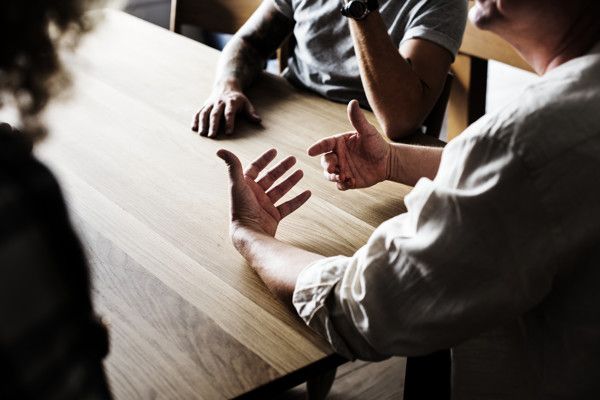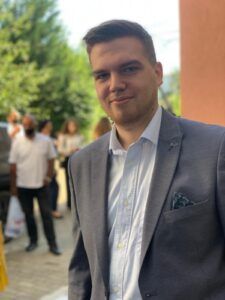Welcome back to the Healing Pain Podcast with Rilind Shala, PT
We’re diving deeper into the utility of Pain Neuroscience Education and investigating if it’s enough to help people overcome pain when used as a single treatment modality or should it be folded into a more comprehensive multimodal pain treatment program? My guest is Rilind Shala who is a young scientist and a physical therapist from Kosovo. He conducts research with the prestigious Body and Mind Group and has earned many international accolades for his work in both physical therapy as well as pain management. In this episode, we cover how Pain Neuroscience Education is used in clinical practice, the clinical impact of Pain Neuroscience Education on outcomes such as kinesiophobia and pain catastrophizing, and the essential tools and techniques you can combine with Pain Neuroscience Education to prove its impact on quality of life. Let’s get ready, let’s begin and let’s learn about Pain Neuroscience Education.
—
Watch the episode here:
Subscribe: iTunes | Android | RSS
Is Pain Education Enough? With Rilind Shala, PT
Rilind, welcome to the show. It’s great to have you.
Thanks for having me.
I’m excited to chat with you. Lots of the work we do here on the show is to reach out to both experienced researchers in the field of physical therapy and pain science. I’m always on the lookout for young scientists like yourself who are doing interesting work and have plans to do interesting work in their PhD. We’re going to talk about a paper that you published. The paper is called Can We Just Talk Our Patients Out of Pain? Should Pain Neuroscience Education Be Our Only Tool? That was printed in the Journal of Manual & Manipulative Therapy. We’re going to talk about the paper, but first, I want you to introduce yourself and tell people who you are, where you’re from, and the direction that your career is going with regard to being an early researcher.
Thanks for having me, Joe. I love your show. I listen to all your episodes. It’s a nice invitation. I’m Rilind Shala. My name is a little bit difficult to pronounce because I come from Kosovo. It’s in Europe near Albania and also near Croatia and the Balkans. I’m an early career researcher. That’s my third paper, more to be published and it’s published in the Journal of Manual & Manipulative Therapy. I am a physical therapist looking to go into a PhD program. I’m more focused on Pain Neuroscience Education, clinical sports medicine, and low back pain research. That’s where my research interest is focused in.
You mentioned this is your third paper. This paper is specifically about Pain Neuroscience Education. What were your first two papers about?
The first paper was about knee OA and it was more focused on the biopsychosocial approach and treating knee OA in a biopsychosocial way. The second paper was about diagnosing low back pain and it was also in a more biopsychosocial and neuroscientific approach so we can look for the source of low back pain and treat it for a more modern explained pain source.
The two papers have steeped in the biopsychosocial model of pain moving toward Pain Neuroscience Education. This paper is about Pain Neuroscience Education. Why was it important for you to write this paper? Why is it important for us to read this paper?
As an early career researcher, before I published those papers, I always read about Pain Neuroscience Education and the biopsychosocial approach. For example, when we read the latest literature, we always see that the biopsychosocial approach as the focus of treatment. If we take a patient and treat him with a biomedical approach, then we treat the patient with the biopsychosocial approach, it will be all a different world for the patient because Pain Neuroscience Education teaches us that we can treat the patient. If he has a little back pain injury or shoulder sprain, we also treat the psychosocial factors. This was an important topic for me because all the literature is focusing on the psycho factors and also the social factors about the pain.
Can you explain Pain Neuroscience Education in your own words and why it’s important?
Pain Neuroscience Education is a tool that teaches. Here in Kosovo, the biomedical approach is widespread. Many people use the biomedical approach. I have had many patients but when we treat the patients with the biopsychosocial approach, it was better for them. With Pain Neuroscience Education, I can understand it a little bit better. We can explain pain, pain neurophysiology or pain neurobiology to the patient so that the patient doesn’t think that pain is the start and the end of the story. If a patient has pain, it’s not the end of the story. We can retrain the nervous system to learn pain and to deal with pain. That’s important for the patient because if the patient thinks that “I have pain. I have nothing to do about it. I lost. I can’t do anything about this pain,” then the patient is practically lost and has also lost the face of health professionals and himself.
Pain Neuroscience Education has been around for a while before the predecessor was explaining pain. Both are useful and evidence-based interventions. They are very similar. Why has PNE started to shift in the world of physical therapy?
That was also important for the paper. When I started to write the paper with Professor Lorimer Moseley, Nathalie Roussel and other authors, we always thought that Pain Neuroscience Education has done a shift in the treatment procedures. We have done in physical therapy, chiropractic, orthopedic and sports medicine. When we treated the patients with biopsychosocial or teaching people about pain, their behavior shifted. As we mentioned in the paper, when we use the Pain Neuroscience Education approach with a patient we also decrease their pain beliefs. When we treat patients with this approach, their fear of pain decrease and their fear avoidance behaviors decrease as well.
I liked the way you framed that because you said behavior shifted. Often, when people talk about Pain Neuroscience Education or any other cognitive dimension, they’re so focused on thoughts and beliefs changing, which we’ll talk about. Sometimes that happens. Sometimes that does not happen. Oftentimes, it doesn’t happen fully, but what we’re looking for is a change in behavior. That’s the point of all these cognitive and behavioral interventions. There should be a change in behavior.

That was also the point of this paper. I think that if we use Pain Neuroscience Education, we can’t do as much with the patient in the sense of the pain decreases. If we can use Pain Neuroscience Education as a tool for the patient to change their behaviors and beliefs, and decrease the pain catastrophizing, then the quality of life or the quality of the treatment that we give will be so much better. If we sit down with a patient and talk every day about pain signals in the nervous system preceding the pain, we can do as much with a patient. If I discuss with them pain and they say, “I’m not so much interested in pain. I have to know what I have to do to be better.” If we can teach pain in a more simplistic way that the patient will learn and listen from us, the patients will change his behavior and his lifestyle.
As the title of your paper says, Can We Talk Our Patients Out of Pain? I’d be remiss not to ask you that question. Can we talk our patients out of pain as your article appropriately asks?
The short answer is we can’t. The positive answer we can get from a neurologist is when we use the Pain Neuroscience Education approach, we can do many other things. If you sit down with the patient and talked every day about pain, we can’t do anything with the patient. I have many patients that are stressed, demotivated, have high levels of anxiety and pain catastrophizing. if we describe pain neuroscience or if we educate the patient, the pain is not the end of the story. If the patient has chronic or persistent pain, it doesn’t mean that it’s all over. It doesn’t mean that the tissues are over. When we educate patients on pain, often, we use the metaphor that pain is not connected with tissue damage. If a patient has chronic low back pain, most of the patients go get the scan. When they get a scan, they come to me and say, “I have seen the scan. The doctor told me I have this bulge. Now I’m screwed. I have to go to surgery.” If he has 6 or 7 months of chronic pain and the pain has more to do with the over-protective nervous system, it has to do with the tissue damage that the patient has.
We cannot talk our patients out of pain, but there are aspects of PNE that are helpful and useful. What are the most important outcomes that we see when we use this? I want to return to that. When we can’t talk our patients out of pain, it points us to the fact that this is an important feature of treatment planning, but it shouldn’t be the sole treatment. We can’t sit someone down for 8 or 4 sessions and talk to them about pain.
In any treatment, the use of a standalone treatment won’t be effective. We can have a patient that has chronic low back pain and we can use acupuncture every day with them, but it won’t be effective. I’ve got many people that read the paper and send me an email and said, “Have you ever talked the patient out of pain?” That’s not how it works. If you use Pain Neuroscience Education or any other treatment as a standalone, it won’t probably work.
Is Pain Neuroscience Education necessary for all pain conditions?
It depends. If we have chronic pain, persistent pain or nociplastic pain where there is an alternation of the central nervous system, and we also have central sensitization or peripheral sensitization, then it’s good to use Pain Neuroscience Education because we can teach the patient when pain is just a protective meter. Pain protects us. If we don’t have pain, then we will probably be dead. We can teach the patient, especially in conditions where the patient has allodynia, primary hyperalgesia or also secondary hyperalgesia, we can educate the patient that pain is not everything. We can say that pain is everything that we teach the patient. When it comes to pain, everything matters. We can explain the pain in a way that the patient understands that he can move, he can run, he can do all the kinds of physical activities that he wants, and he can live again.
You mentioned central sensitization which everyone in this show is pretty well versed on if they’d been following this over the course of the last few years. You mentioned nociplastic pain, which is a relatively new definition that came out of the International Association for the Study of Pain. It replaced central sensitization in a certain way. Can you explain what nociplastic pain is in a little bit more layman terms?
If a patient has a condition that has altered the central processing mechanism or if the pain processing nervous system is altered, then the patient will have nociplastic pain. The good news is that this pain like nociplastic, neuropathic or normal pain all will be influenced by exercise. If we move, run or do physical activity, all this will be better. If the patient can move, exercise and live his life as he wants, then all the central pain mechanisms will be altered. We also know that in the body, we have a mechanism that produces opioids. If we do manual therapy and the patient can move, then the opioids will be produced and the pain will be decreased.
You mentioned central mechanisms and in some way, you mentioned a peripheral treatment to impact them.
That has an indirect mechanism or indirect influence on central pain.
Direct influence might be something like Pain Neuroscience Education or Acceptance and Commitment Therapy where it has an impact on fear-avoidance, pain catastrophizing and pain acceptance. Those are all more central and immediate mechanisms.
They are also interconnected. If we use Pain Neuroscience Education, we can also use all of those treatments. This has been called PNE-Plus because this plus has added movement, exercise, behavior therapies, and Acceptance Commitment Therapy. We can all use these kinds of mechanisms or tools we have. We impact the patient’s pain and his life.

We have many tools to impact nociplastic pain.
Many tools if we can use them. If we use Pain Neuroscience Education to teach the patient that you can move, exercise and do all kinds of physical activities, then we have reached our goal to treat the patient. If we use Pain Neuroscience Education to teach the patient the mechanism with pain, the narrow physiology of pain and the neurobiology of pain, then we can’t do much for this patient. If we influence the life of the patient in some way and educate the patient that he can move, it’s is no problem that he has knee OA, it’s no problem that he has chronic low back pain, and the patient can start to move again. The fear of those beliefs will change. He will start to flex. If we are talking about chronic low back pain, he will start to move and run again so we have improved the life of the patient.
I spoke with Adriaan Louw about PNE Plus. That’s why I wanted to connect with you because the paper you publish adds to that aspect and literature where pain neuroscience or explained pain has its place. Every practitioner should be using it, but we need to plus or tag something on to that treatment. As physical therapists, exercise and manual therapy are high on the list. It’s interesting, as I read through your paper, there’s one line somewhere that states that PNE or explaining pain helps people move better and teaches them to move even if the pain is present. I’ve trained a lot in mindful and acceptance-based approaches. I know this hasn’t been studied well or at all, but there’s probably a little bit of pain acceptance happening even within a PNE aspect. If you tag on something like mindfulness and Acceptance and Commitment Therapy, it may be more effective with regard to that pain acceptance aspect.
That’s what we also think about Pain Neuroscience Education because if we teach the patient in the right way, then most of the patients will not be fearful about pain. There’s also a study where the patients think about the movement of the shoulder. When they thought about the movement of the shoulder, the shoulder started to hurt. If we teach the patients that they should not be fearful about pain, they can start to move again and do all kinds of physical activities despite pain.
There are some aspects of pain exposure.
From this, there are so many treatments derived like graded motor imagery and many other treatments that we can have pain, but we can also do all kinds of physical activities that we like. We can live our life the way we can.
One of the areas of your interest is manual therapy. You’re going to probably do some research in that area in the future as you delve into your PhD. I’m wondering how you see the research being built out with regard to manual therapy and Pain Neuroscience Education. Those connections have been discussed in the literature, but not the way we’ve discussed the cognitive aspect of PNE. We haven’t discussed much how manual therapy has an impact on those central mechanisms that we spoke about. We talk a lot about how manual therapy has an impact on peripheral mechanisms, but how does it impact those central mechanisms?
Like Pain Neuroscience Education, we can also use manual therapy but if you use manual therapy, the focus should not be on the structure that we treat. We have also seen a shift nowadays because manual therapy was used several years ago. When physical therapists treat patients with manual therapy, the focus was also on the structure. When we treat lower back pain, the focus wasn’t this. If we can do manipulation, then we can solve this issue. If we use manual therapy, we can get short-term outcomes mainly. We are also doing a paper about manual therapy. We have nowhere seen that if we use manual therapy, that the patient will be dependent on the physical therapist or chiropractor that is doing this kind of treatment.
We can use manual therapy as a support treatment with Pain Neuroscience Education so we can teach the patients that can move again. Even if we do this manipulation, mobilization or any other therapies, we can also educate the patient about pain. There is no connection to be seen here because if we educate the patient that he can move again, and we do manual therapy, the focus should not be on the structure that we treat. We should not say to the patients that if we do a mobilization or manipulation, then we can do some kind of magic tricks with them.
When you’re explaining mobilization or manipulation, we should very much pull back and limit the pure biomechanical explanation and start to explain how it impacts the nervous system.
The narrow physiological effect of manual therapy.
Can you give me an example of that? Let’s say I have a patient and I’m doing a simple PA mobilization on their lumbar spine to increase lumbar spine extension. What I gave you right there is a biomechanical explanation. I’m doing that so I can increase the range of motion on the joint. How would you explain it to a patient in a way that’s more in line with Pain Neuroscience Education approach?
If we did this manipulation, the solution is we didn’t impact the part that we treated, but we impact the central nervous system. The central nervous system would be impacted in a way that if we treat or do a mobilization or the patient run or does any physical activity, the pain mechanisms that process pain will calm down. If a physical therapist or chiropractor treats the patient, the pain mechanisms will decrease because the central nervous system or the brain produces pain. When the brain sees that everything is okay and the patient can move, we can touch and mobilize the structure, the pain will decrease because there is no danger or there’s no nociceptive mechanism that will activate pain or that will increase the pain for the patient.

This touch in general or manual therapy is helping to decrease the sensitivity of your nervous system.
The sensitivity will always be decreased if we do some mobilization or physical activity. If the central nervous system is sensitized, then the patient will always have pain because if the patient has chronic or persistent pain, the brain or the central nervous system will learn to produce pain. This will increase until the nervous system is retrained to have pain and to move despite the pain.
Often, when therapists first come to things like Pain Neuroscience Education, Cognitive Behavioral Therapy, Acceptance and Commitment Therapy or mindfulness, one of the challenges they have is, “How do I fit this in? How do I divide my time up? How do I organize a treatment session?” I tell therapists all the time, “Don’t take out manual therapy. You may have to modify some of it, but don’t take it out and use that time with the patient as a way to not only deliver effective manual therapy but to deliver an effective cognitive intervention.” That’s one thing that we have as physical therapists that we can utilize that psychologists don’t have. Psychologists can work on the cognitive and the talking aspect just like we can, but we can also do that in a way where it’s laid over manual therapy or laid over exercise. That’s the real beauty of all these different types of interventions, but it takes therapists a little while to figure out, “How do I organize this in my plan of care over the course of eight weeks, and how do I organize it within a single treatment session?” What you said is key. Use it with manual therapy and exercise.
One thing that physical therapist and all other medical professionals have to understand is that there is no competition between manual therapy, acupuncture or Pain Neuroscience Education. They can all work together to get the best out of the patient. Many people see this as a competition, “I’m not a psychologist. I can’t use education. I wanted to treat the patient. I will do manual therapy. I will give exercises to the patient. That’s it.” These treatments are all effective if we use them all together.
That’s the real key there. I appreciate that. Rilind, it has been great chatting with you about your paper, Can We Just Talk Our Patients Out of Pain? Should Pain Neuroscience Education Be Our Only Tool? You can find that in the Journal of Manual & Manipulative Physical Therapy 2021. Make sure you check that out. It’s been great chatting with you. I wish you well as an early career researcher. I’m interested to see what you produce over the next 2 to 4 years as you work through your PhD. In the meantime, let everyone know how they can reach out to you and learn more.
I am on Twitter @RilindShalaPT. We also have ResearchGate and Google Scholar. I’m also on Facebook at RilindShala. They can look at all other papers and other projects that we are doing with the team.
At the end of every episode, I ask you to share this out with your friends, family and colleagues who are interested in pain and Pain Neuroscience Education. Share it on Facebook, Twitter, LinkedIn, Instagram, Facebook group or another group where people are talking about the effective care of chronic pain. I’ll see you in the next episode.
Important Links:
- Rilind Shala – LinkedIn
- International Association for the Study of Pain
- Can We Just Talk Our Patients Out of Pain? Should Pain Neuroscience Education Be Our Only Tool? – Article
- Adriaan Louw – previous episode
- @RilindShalaPT – Twitter
- ResearchGate – Rilind Shala
- Google Scholar – Rilind Shala
- Rilind Shala – Facebook
About Rilind Shala
 Rilind Shala is a young scientist and a physical therapist from Kosovo. He does research with the Body in Mind Group and also serves as a supervisor in Publons. He has earned many international accolades, with the recent one being the Best Reviewer of 2020 in the University of Prishtina as awarded by Publons.
Rilind Shala is a young scientist and a physical therapist from Kosovo. He does research with the Body in Mind Group and also serves as a supervisor in Publons. He has earned many international accolades, with the recent one being the Best Reviewer of 2020 in the University of Prishtina as awarded by Publons.
Love the show? Subscribe, rate, review, and share!
Join the Healing Pain Podcast Community today:
